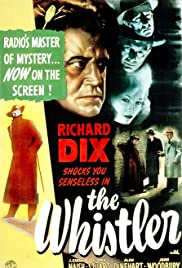
THE WHISTLER
US, 1944, 60 minutes, Black-and-white.
Richard Dix, J. Carroll Naish, Gloria Stuart.
Directed by William Castle.
The Whistler was originally a radio program on CBS, from 1942 to 1955.
A series of eight films began in 1944, small supporting features at Columbia. Four of the films were directed by William Castle who, during the 1950s, directed small budget action adventures like Slaves of Babylon, Saracen Blade. From 1958 to 1968 he made a number of exploitative horror films with all kinds of gimmicks to scare audiences, House on Haunted Hill, I Saw What you Did. He also produced Rosemary’s Baby.
• The Whistler - 1944, directed by William Castle
• The Mark of the Whistler - 1944, directed by William Castle
• The Power of the Whistler – 1945, directed by Lew Landers
• Voice of the Whistler – 1945, directed by William Castle
• Mysterious Intruder – 1946, directed by William Castle
• The Secret of the Whistler – 1946, directed by George Sherman
• The Thirteenth Hour – 1947, directed by William Clemens
• The Return of the Whistler – 1948, directed by D. Ross Lederman
As with the radio program, the films are introduced by a shadowy figure walking across the screen, with his signature whistling, which sometimes recurs throughout the film is. He begins to speak, is a narrator of stories about crime, sometimes intervening with narration during the action of the films.
The star of seven of the eight of the films was Richard Dix who had begun his silent film career in 1917, was a popular star for the next 30 years, appearing in the 1931 Academy Award winning Cimarron.
The interesting point about Richard Dix’s presence is that he portrayed a different character in each film. Most of the characters are not entirely sympathetic, ambiguous in their moral attitudes, sometimes swinging between the law and working outside the law.
As with the radio program, the films are introduced by a shadowy figure walking across the screen, with his signature whistling, which sometimes recurs throughout the film is. He begins to speak, is a narrator of stories about crime, sometimes intervening with narration during the action of the films.
The star of seven of the eight of the films was Richard Dix who had begun his silent film career in 1917, was a popular star for the next 30 years, appearing in the 1931 Academy Award winning Cimarron.
The interesting point about Richard Dix’s presence is that he portrayed a different character in each film. Most of the characters are not entirely sympathetic, ambiguous in their moral attitudes, sometimes swinging between the law and working outside the law.
In the original film, Dix portrays a man who goes to a bar near the waterfront, contacts a man who has connections with the underworld and pays for a hit on himself. It emerges that he was unkind to his wife, that she was captured by the Japanese and imprisoned by them – although later telegram comes to say that she has been freed.
His character is erratic in coming to the office, helped by his secretary, played by Gloria Stuart who had a long career and who, half a century later or more, appeared in Titanic. There are quite a number of interesting characters in small roles, a sympathetic bartender, the deaf mute who delivers messages to the killer, the killer himself, played by J. Carroll Naish, who intends to do the contract even when he hears that the man himself does not want to be killed. There are complications as he follows his target and actually shoot another man in a factory, pursued by the law, conversations with a wealthy friend who encourages him, a final confrontation with his target.
The plot is complicated when the agent for arranging the killing is soon shot by police, he being a killer himself.
Dix’s character undergoes all kinds of trauma, sympathy from his secretary, concerns about him from his business partner, concerns about his wife, his desperate efforts to stop the contract on himself, a car trip with the wife of the agent – and his escape from a crash, amnesia, going to the port, trying to carry goods onto a ship for Red Cross relief – and then rescued and discovering the truth that his wife has died in the camp, and about himself.